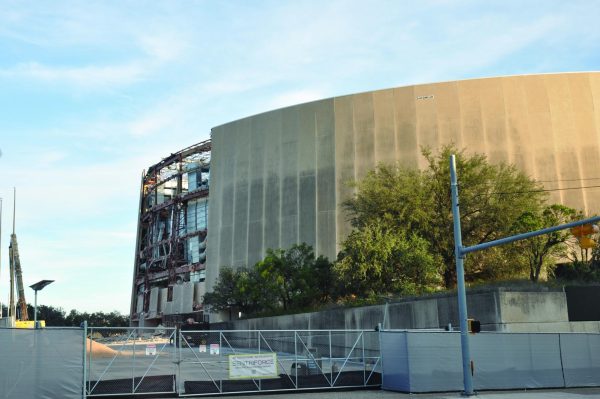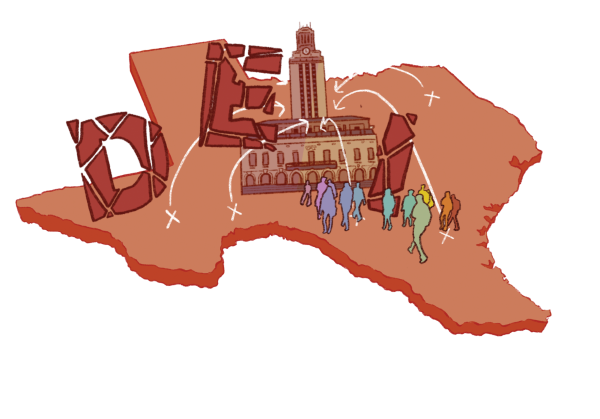Budget Crisis
$30M in the hole, district considers cuts to magnet busing, staffing
December 10, 2018
Dozens of teachers, parents, students and community members crowded into the McCallum cafeteria on Nov. 7 to discuss education finance with volunteer committee members — not traditionally the biggest draw. However, this group’s mission is more urgent than boring: saving the Austin Independent School District (AISD) from bankruptcy.
In the quest to make up a multi-million dollar deficit, the committee floated ideas including completely cutting magnet programs, eliminating special magnet transportation, instituting a pay-to-ride system for magnet transportation, and reforming the magnet staffing allocation.
The Budget Stabilization Task Force (BSTF) was created over the summer of 2018, and tasked with providing recommendations for balancing the budget and making up for a $30 million deficit. After requesting several extensions, the group hopes to give recommendations to the Board of Trustees in 2019, said Claire Milam, tri-chair of the BSTF.
“We were called by [AISD Superintendent] Dr. Cruz to look and then ultimately perhaps make some recommendations,” Milam said. “They also hired a consulting group to do similar things because Austin ISD did not balance their budget for the 2018-19 school year. They went into their reserves. And that’s not sustainable.”
Recapture
Although the district receives over a billion dollars annually in taxes, as a property-rich district it sends nearly half of its revenue to the state per the “Robin Hood” recapture law. The money the district sends to the state is then redistributed to property-poor school districts without the ability to collect enough tax money to cover their expenses. LASA Principal Stacia Crescenzi said there is a lack of awareness in the student body about recapture, one of the main reasons AISD faces the shortfall it does.
“I wish students understood more why the district had these problems,” Crescenzi said. “Let’s pretend for a second we got all that money back, that would be $8,000 per student. My non-staffing costs, what I get per student, is $120.34. This would be such a different conversation.”
The Robin Hood system, which has been criticized for accounting poorly for the different costs of educating underprivileged students, draws increasing amounts of money from AISD as Austin property values rise. Although the district is planning to advocate reforms at the next legislative session, for now they have to work within a system of austerity. LASA Campus Advisory Council (CAC) co-chair Ann Phipps said real cuts would have to be made to achieve balance.
“There’s no 30 million dollars hiding under a rock that they can just go turn over the rock and go ‘There it is! We’re out of trouble!’” Phipps said. “That’s just not going to happen.”
Although the committee’s primary goal is cost saving, Milam said not all of the big-dollar possible cuts would be effective policy. One idea, touted as a source of multimillion-dollar savings, proposed teachers instructing one more block each, or seven of eight blocks. It was met with vehement opposition in public comment and did not make it out of the staffing subcommittee.
“When you do that give and take game, the budget game, I think that if you’re looking to close a $30 million gap, if you have middle and high school teachers teach an additional class period, that’s $15 million,” Milam said. “And then if you increase the class size … by one student in every class that’s another $15 million, and then 15 and 15 makes 30. But that is not a good idea. That is not a very good idea.”
The recommendations the committee eventually makes will receive community input and then pass to the superintendent. Although the process has gone on longer than originally planned, to avoid bankruptcy the district will need to make significant cuts starting in the next school year.
“When we look at the legislature and the public education funding, there’s not really much more room to cut,” Milam said. “The easy choices have been made long ago.”
Magnets
The BSTF looked closely at magnet and specialty programs in their search for possible cuts, with one sub-committee proposing eliminating magnets, magnet busing, and the extra magnet staff allocation. Milam said ideally, all recommendations would be phased in long term.
“It would be short sighted to make a sudden cut that could really affect access to education at LASA,” Milam said. “Anything should really be within part of a multi year plan that includes the campus move.”
If approved by the BSTF, the recommendations would not be immediately enacted. They pass over to Superintendent Paul Cruz, who can examine them and decide which to propose to the board.
Crescenzi said that any recommendation to close down or reduce size of the magnets would likely lead to a decrease in overall AISD enrollment, therefore further lowering funding and exacerbating budget issues.
“I don’t know how much other schools bring back to the district in terms of bringing new students, but in general 15 or so percent of any incoming class at LASA were not in AISD public schools the year before,” Crescenzi said. “They were in privates, or charters, or homeschooled. So we bring money to the district.”
Transport
Milam said that the magnet transport was a more likely spot for cuts to be made. The three magnet programs with guaranteed transportation — LASA, Fulmore, and Kealing — spend millions on busing annually.
“AISD could triple the number of magnet invested campuses in the district for the amount it spends on busing,” Milam said. “The magnet programs, LASA being one of them, are spending about $6 million a year on the AISD school buses … Is that the best use of that money?”
However, LASA CAC co-Chair Melanie Plowman said the transport was worth the cost, especially given the school’s goals for student body diversity. Just ten percent of LASA students are economically disadvantaged (low SES), a low ratio in a district where over half of students are low SES. The school has worked to increase its economic diversity, including by weighting economic status in the admissions process, and Plowman said restrictions on transport could further stratify access.
“I don’t think it would be the same school at all,” Plowman said. “You would have much more concentrated wealth in the school. It’d be people whose parents are available to drive them to school … it’d be parents who can buy their kids a car or who live in neighborhoods where there are lots of LASA kids who can figure out a carpool, I think it’s a much different LASA because you have just narrowed the scope of who can even come.”
Milam said there were more conversations to be had about the nuances of the plans before they were improved by the committee.
“Even some of the [recommendations] that get out of the subcommittee,” Milam said, “we’re like, ‘right, don’t we value student achievement? Aren’t these some of our best programs? Aren’t these some of our highest achieving students?’”
Staffing
The final possible recommendation, adjusting staffing allocation, should be considered as a part of a larger overhaul of magnet staffing funding procedures , Crescenzi said. Currently, magnet schools receive an extra 25 to 30 percent staffing allocation, including funding for signature course teachers. However, LASA does not receive certain administration members that non-magnet schools do. LASA currently trades some extra allocation spots to hire counselors and assistant principals, among others. However, with a $30 million deficit, Crescenzi said all schools will have to make cuts — including LASA. In FY2018, the school’s budget was $4,814 per student, one of the lowest among district high schools.
“Sometimes it’s easy for people to look and say, ‘I wanna keep everything in my world the same so I’m happy to vote for cuts that have nothing to do with me,’” Crescenzi said. “We have to step back from that and say what are the programs, positions, [and] departments that really work and find other ways to give services to students.”
When making cuts, Plowman said it was important to try and preserve the integrity of programs and avoid directly affecting students. The BSTF has emphasized the importance of an equity lens when looking at programmatic cuts.
“The district is in a really difficult situation,” Plowman said. “I don’t know if anyone has the answer on where there can be cuts … but these magnet proposals and the effect they could have on our student body is ill-advised and [will] really change the nature of the magnet schools we have … I think it’s gonna have impacts that undermine our efforts to improve diversity.”
Back at the meeting, the staffing subcommittee presented to the BSTF and packed cafeteria. Clicking through powerpoint slides on staffing possibilities, BSTF member Mike Cranor commented on the district’s spending.
“This is not a race to the bottom,” Cranor said. “It’s a race to the middle.”









